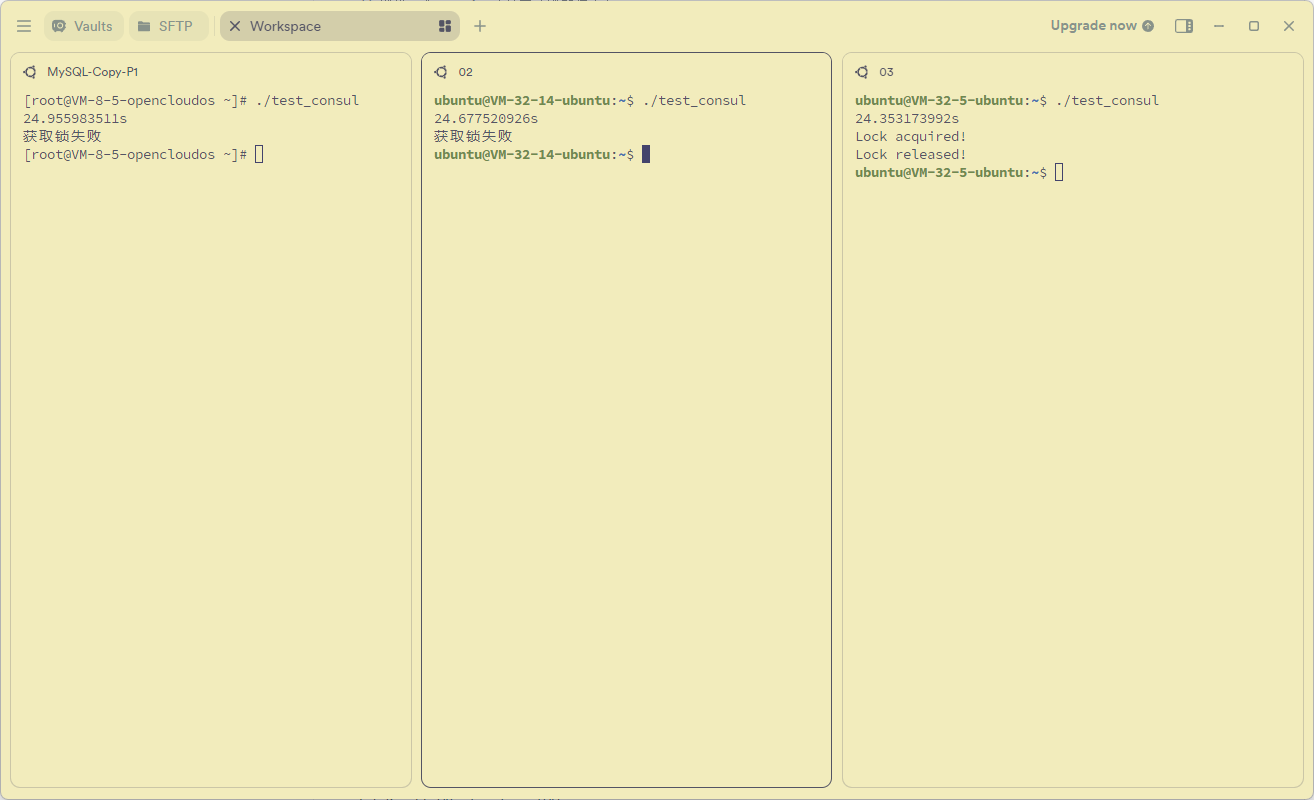操作系统: Ubuntu 24.04 LTS / CentOS 9
Consul版本: 1.24.1
ssh客户端: termius 9.28.0
(Ubuntu)安装软件-apt
https://developer.hashicorp.com/consul/install找到对应系统的安装命令
sudo ufw disable #先关闭防火墙
wget -O - https://apt.releases.hashicorp.com/gpg | sudo gpg --dearmor -o /usr/share/keyrings/hashicorp-archive-keyring.gpg
echo "deb [arch=$(dpkg --print-architecture) signed-by=/usr/share/keyrings/hashicorp-archive-keyring.gpg] https://apt.releases.hashicorp.com $(grep -oP '(?<=UBUNTU_CODENAME=).*' /etc/os-release || lsb_release -cs) main" | sudo tee /etc/apt/sources.list.d/hashicorp.list
sudo apt update && sudo apt install consulconsul -v配置文件目录:/etc/consul.d (下面有一个初始的consul.hcl配置文件)
systemctl的service文件所在路径:/usr/bin/systemd/system/consul.service
(CentOS系列)安装软件-yum
sudo systemctl stop firewalld #先关闭防火墙
sudo yum-config-manager --add-repo https://rpm.releases.hashicorp.com/RHEL/hashicorp.repo
sudo yum -y install consul
consul -v配置文件
每个服务器节点在/etc/consul.d目录中添加一个JSON配置文件
第一台服务器将其中的129.211.xxx.xxx为公网IP
后续服务器除修改IP外,将bootstrap_expect这一行删除(只有第一个节点需要bootstrap mode)
{
"server": true,
"bootstrap_expect": 1,
"bind_addr":"0.0.0.0",
"client_addr":"0.0.0.0",
"advertise_addr":"129.211.xxx.xxx",
"data_dir":"/opt/consul",
"ui_config":{
"enabled": true
}
}放通端口
端口:8300、8301、8302、8500、8501、8600
如果是云服务器,需要注意有二处需要放通,操作系统的防火墙和云服务器的安全组。
启动
sudo systemctl enable consul
sudo systemctl start consul #如果启动长时间卡住,CTRL+C中断即可,服务其实已经启动join到集群
第二台和第三台分别执行命令行:
consul join <第一台服务器的IP>
consul members #查看集群状态也可以在http://<公网IP>:8500网页上查看
golang测试分布式锁-KV方式
程序会在下一个30秒或整分的时候执行
go get github.com/hashicorp/consul/apipackage main
import (
"fmt"
"log"
"time"
"github.com/hashicorp/consul/api"
)
func main() {
var timeCur = time.Now()
var nextMinute time.Time
if timeCur.Second() < 30 {
nextMinute = time.Date(timeCur.Year(), timeCur.Month(), timeCur.Day(), timeCur.Hour(), timeCur.Minute(), 30, 0, time.Local)
} else {
nextMinute = time.Date(timeCur.Year(), timeCur.Month(), timeCur.Day(), timeCur.Hour(), timeCur.Minute(), 59, 0, time.Local)
}
var duration = nextMinute.Sub(timeCur)
fmt.Println(duration)
time.Sleep(duration)
// 创建 Consul 客户端配置
config := &api.Config{
Address: "localhost:8500", // 替换为你的 Consul 地址
}
client, err := api.NewClient(config)
if err != nil {
log.Fatalf("failed to create Consul client: %v", err)
}
// 获取 KV 和 Session API
kvs := client.KV()
session := client.Session()
// 创建一个 session(分布式锁的核心)
sessionID, _, err := session.Create(&api.SessionEntry{
Behavior: api.SessionBehaviorRelease, // 释放会话后释放锁
TTL: "10s", // 会话的生存时间
}, nil)
if err != nil {
log.Fatalf("failed to create session: %v", err)
}
defer session.Destroy(sessionID, nil)
// 获取一个独占锁的 Key
lockKey := "lock/key01"
// 尝试获取锁
lockValue := []byte("locked")
lockPair := &api.KVPair{
Key: lockKey,
Value: lockValue,
Session: sessionID,
}
// 设置分布式锁(使用 Key/Value 存储)
b1, _, err := kvs.Acquire(lockPair, nil)
if err != nil {
log.Printf("failed to acquire lock: %v", err)
return
}
if b1 == false {
fmt.Println("获取锁失败")
return
}
fmt.Println("Lock acquired!")
// 模拟业务处理
time.Sleep(5 * time.Second)
// 释放锁
_, _, err = kvs.Release(lockPair, nil)
if err != nil {
log.Printf("failed to release lock: %v", err)
return
}
fmt.Println("Lock released!")
}
编绎后放到三台服务器,chmod 777 <程序名>给权限

golang使用consul仿原生锁(锁原语)
如果无法取得锁会一直等,像GOLANG原生的锁Lock和Unlock一样使用
要注意的是用LockOpts的session会有协程自动做续期(renew),如果锁不释放session一直不会过期
package main
import (
"fmt"
"time"
"github.com/hashicorp/consul/api"
)
func main() {
client, _ := api.NewClient(&api.Config{
Address: "localhost:8500",
})
for i := 0; i < 3; i++ {
go func(n int) {
lock, _ := client.LockOpts(&api.LockOptions{
Key: "lock2",
Value: []byte(fmt.Sprintf("test_lock%d", n)),
SessionOpts: &api.SessionEntry{
Behavior: api.SessionBehaviorDelete,
TTL: "15s",
},
LockTryOnce: false, //只尝试一次等于false
})
stopCh := make(chan struct{})
_, err := lock.Lock(stopCh)
if err != nil {
fmt.Println(i, time.Now().Format(time.DateTime), "取锁失败", err)
return
}
defer func() {
err := lock.Unlock()
fmt.Println(i, time.Now().Format(time.DateTime), "释放锁", err)
}()
fmt.Println(i, time.Now().Format(time.DateTime), "取锁成功")
time.Sleep(time.Second * 20) //模拟业务执行
}(i)
}
time.Sleep(time.Hour)
}

